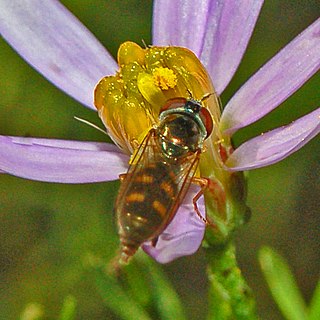
Chrysotoxum cautum is a species of Palearctic hoverfly of the genus Chrysotoxum. The larvae are thought to feed on root aphids. Adults are usually found on the edges of woodland or scrub or along hedgerows where they visit a wide range of flowers, usually in small numbers.

Platycheirus clypeatus is a species of hoverfly. It is found across the Palearctic and in the Nearctic. The larvae feed on aphids. Adults are usually found on the edges of woodland or scrub, heath or along hedgerows where they visit a wide range of flowers.

Platycheirus scambus is a species of hoverfly. It is a Holarctic species.

Platycheirus peltatus is a Palearctic species of hoverfly.

Leucozona lucorum is a Palearctic and Nearctic species of hoverfly.

Platycheirus scutatus is a very common species of hoverfly. It is a Holarctic species.

Platycheirus fulviventris is a Palearctic species of hoverfly. It is found in many parts of Britain and Europe.

Platycheirus granditarsus, the Hornhand Sedgesitter, is a species of hoverfly. It is found in many parts of Britain North America and Europe. Typical habitat includes marshy meadows and ditches, where it can be found between May and October, though it is at its commonest between July and September. The most distinctive feature of this fly is the red-orange abdomen most easily seen as it takes off or alights.

Platycheirus manicatus is a species of hoverfly. It is found across the Palearctic and in Alaska.

Epistrophe grossulariae is a Holarctic species of hoverfly.

Cheilosia latifrons is a species of 'flower flies' or hoverflies belonging to the family Syrphidae subfamily Eristalinae.

Pipizella viduata is a species of Hoverfly, from the family Syrphidae, in the order Diptera.

Platycheirus ambiguus is a small widespread species of hoverfly found across the Palearctic from Ireland to Japan. A spring species found in flight in April and May, it visits spring-flowering trees and shrubs, e.g., Prunus spinosa in deciduous woodland and scrub.

Platycheirus angustatus is a species of hoverfly. It is found in many parts of the Palearctic, and in the Nearctic.
Platycheirus perpallidus is a species of hoverfly. It is a Holarctic species.

Paragus haemorrhous, the Black-backed Grass Skimmer is a common widespread species of hoverfly found in many parts of Europe, Africa and the Nearctic. Hoverflies can remain nearly motionless in flight. The adults are also known as flower flies for they are commonly found on flowers from which they get both energy-giving nectar and protein-rich pollen. The larvae are predators on aphids.

Eumerus funeralis or lesser bulb fly is a species of Hoverfly, from the family Syrphidae, in the order Diptera. E. funeralis appears in Peck (1988) as a synonym of E. strigatus (Fallen), but was reinstated as the correct name for tuberculatus Rondani, sensu auctorum by Speight et al. (1998).

Eumerus strigatus, the onion bulb fly, is a fairly common species of syrphid fly observed across Europe. Also found in north-central North America and other scattered locations as an introduced species from infested bulbs. Syrphid flies are also known as hover flies or flower flies because the adults are frequently found hovering around flowers from which they feed on nectar and pollen. The larvae feed on various bulbs.

Cheilosia impressa is a Palearctic species of hoverfly. Like most members of its genus C. impressa is a rather small, dark insect and identification can be problematic.
Chrysotoxum fasciatum is a species of Holarctic hoverfly.

















